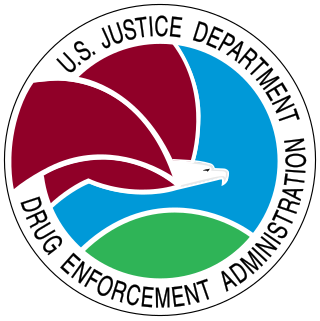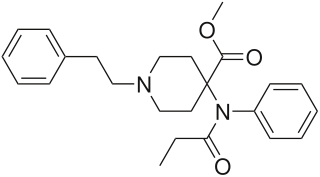
Heroin, also known as diacetylmorphine and diamorphine among other names, is a morphinan opioid substance synthesized from the dried latex of the opium poppy; it is mainly used as a recreational drug for its euphoric effects. Heroin is used medically in several countries to relieve pain, such as during childbirth or a heart attack, as well as in opioid replacement therapy. Medical-grade diamorphine is used as a pure hydrochloride salt. Various white and brown powders sold illegally around the world as heroin are routinely diluted with cutting agents. Black tar heroin is a variable admixture of morphine derivatives—predominantly 6-MAM (6-monoacetylmorphine), which is the result of crude acetylation during clandestine production of street heroin.

Fentanyl is a highly potent synthetic piperidine opioid primarily used as an analgesic. It is 30 to 50 times more potent than heroin and 100 times more potent than morphine; its primary clinical utility is in pain management for cancer patients and those recovering from painful surgeries. Fentanyl is also used as a sedative. Depending on the method of delivery, fentanyl can be very fast acting and ingesting a relatively small quantity can cause overdose. Fentanyl works by activating μ-opioid receptors. Fentanyl is sold under the brand names Actiq, Duragesic, and Sublimaze, among others.

The Drug Enforcement Administration (DEA) is a United States federal law enforcement agency under the U.S. Department of Justice tasked with combating illicit drug trafficking and distribution within the U.S. It is the lead agency for domestic enforcement of the Controlled Substances Act, sharing concurrent jurisdiction with the Federal Bureau of Investigation, the U.S. Immigration and Customs Enforcement, and U.S. Customs and Border Protection. However, the DEA has sole responsibility for coordinating and pursuing U.S. drug investigations both domestically and internationally.

A drug overdose is the ingestion or application of a drug or other substance in quantities much greater than are recommended. Typically it is used for cases when a risk to health will potentially result. An overdose may result in a toxic state or death.

Speedball, powerball, or over and under is the polydrug mixture of a stimulant with a depressant, usually an opioid. The most well-known mixture used for recreational drug use is that of cocaine and heroin; however, amphetamines can also be mixed with morphine and/or fentanyl. A speedball may be taken intravenously or by nasal insufflation.

Carfentanil or carfentanyl, sold under the brand name Wildnil, is an extremely potent opioid analgesic used in veterinary medicine to anesthetize large animals such as elephants and rhinoceroses. It is typically administered in this context by tranquilizer dart. Carfentanil has also been used in humans to image opioid receptors. It has additionally been used as a recreational drug, typically by injection, insufflation, or inhalation. Deaths have been reported in association with carfentanil.

The war on drugs is the policy of a global campaign, led by the United States federal government, of drug prohibition, foreign assistance, and military intervention, with the aim of reducing the illegal drug trade in the US. The initiative includes a set of drug policies that are intended to discourage the production, distribution, and consumption of psychoactive drugs that the participating governments, through United Nations treaties, have made illegal.

Xylazine is a structural analog of clonidine and an α2-adrenergic receptor agonist, sold under many trade names worldwide, most notably the Bayer brand name Rompun, as well as Anased, Sedazine and Chanazine.
Lacing or cutting, in drug culture, refer to the act of using a substance to adulterate substances independent of the reason. The resulting substance is laced or cut.

α-Methylfentanyl an opioid analgesic that is an analog of fentanyl. It is sometimes sold as "China White".

The drug policy in the United States is the activity of the federal government relating to the regulation of drugs. Starting in the early 1900s, the United States government began enforcing drug policies. These policies criminalized drugs such as opium, morphine, heroin, and cocaine outside of medical use. The drug policies put into place are enforced by the Food and Drug Administration and the Drug Enforcement Administration. Classification of Drugs are defined and enforced using the Controlled Substance Act, which lists different drugs into their respective substances based on its potential of abuse and potential for medical use. Four different categories of drugs are Alcohol, Cannabis, Opioids, and Stimulants.

Medetomidine is a veterinary anesthetic drug with potent sedative effects and emerging illicit drug adulterant.

The Sinaloa Cartel, also known as the Guzmán-Loera Organization, the Federation, the Blood Alliance, or the Pacific Cartel, is a large, transnational organized crime syndicate based in the city of Culiacán, Sinaloa, Mexico that specializes in illegal drug trafficking and money laundering.

The US federal government is an opponent of the illegal drug trade; however, state laws vary greatly and in some cases contradict federal laws.

Acetylfentanyl is an opioid analgesic drug that is an analog of fentanyl. Studies have estimated acetylfentanyl to be 15 times more potent than morphine, which would mean that despite being somewhat weaker than fentanyl, it is nevertheless still several times stronger than pure heroin. It has never been licensed for medical use and instead has only been sold on the illicit drug market. Acetylfentanyl was discovered at the same time as fentanyl itself and had only rarely been encountered on the illicit market in the late 1980s. However, in 2013, Canadian police seized 3 kilograms of acetylfentanyl. As a μ-opioid receptor agonist, acetylfentanyl may serve as a direct substitute for oxycodone, heroin or other opioids. Common side effects of fentanyl analogs are similar to those of fentanyl itself, which include itching, nausea, and potentially fatal respiratory depression. Fentanyl analogs have killed hundreds of people throughout Europe and the former Soviet republics since the most recent resurgence in use began in Estonia in the early 2000s, and novel derivatives continue to appear.

There is an ongoing opioid epidemic in the United States, originating out of both medical prescriptions and illegal sources. It has been called "one of the most devastating public health catastrophes of our time". The opioid epidemic unfolded in three waves. The first wave of the epidemic in the United States began in the late 1990s, according to the Centers for Disease Control and Prevention (CDC), when opioids were increasingly prescribed for pain management, resulting in a rise in overall opioid use throughout subsequent years. The second wave was from an expansion in the heroin market to supply already addicted people. The third wave starting in 2013 was marked by a steep 1,040% increase in the synthetic opioid-involved death rate as synthetic opioids flooded the US market.

The opioid epidemic, also referred to as the opioid crisis, is the rapid increase in the overuse, misuse/abuse, and overdose deaths attributed either in part or in whole to the class of drugs called opiates/opioids since the 1990s. It includes the significant medical, social, psychological, demographic and economic consequences of the medical, non-medical, and recreational abuse of these medications.
Harm reduction consists of a series of strategies aimed at reducing the negative impacts of drug use on users. It has been described as an alternative to the U.S.'s moral model and disease model of drug use and addiction. While the moral model treats drug use as a morally wrong action and the disease model treats it as a biological or genetic disease needing medical intervention, harm reduction takes a public health approach with a basis in pragmatism. Harm reduction provides an alternative to complete abstinence as a method for preventing and mitigating the negative consequences of drug use and addiction.
Since 2017, the number of fatalities in California attributable to synthetic opioids has increased by 1,027%. Fentanyl has caused 20% of deaths among California's teenagers and young adults. California has made legal efforts to tackle the opioid issue, including patrols, assistance grants, and education.
Hanhong Pharmaceutical Technology Co. is a Chinese drug manufacturer. The company, its owner Du Changgen and some of its employees are indicted by the United States Justice Department for crimes relating to fentanyl, xylazine and methamphetamine production, distribution of synthetic opioids, and sales resulting from precursor chemicals. The indictments accuses Hanhong of exporting large quantities of fentanyl precursors and non-opioid additives like xylazine, to drug traffickers in Mexico and the United States. Its owner Du Changgen is the head of the Du Transnational Criminal Organization, which is listed on the United States Attorney General’s Consolidated Priority Organization Target (CPOT) list, which according to the DEA is a list of the leaders of the most prolific drug trafficking and money laundering organizations, having the greatest impact on the United States illicit drug supply.















